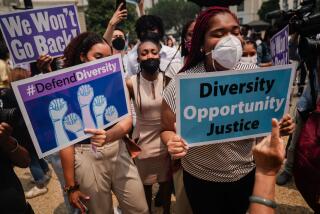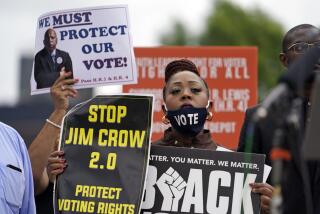Sonia Sotomayor gets it right in Michigan affirmative action dissent

- Share via
Supreme Court Justice Sonia Sotomayor’s dissent from the high court’s 6-2 decision Tuesday to uphold Michigan’s voter-approved ban on affirmative action for public universities has been variously described as “blistering,” “scathing,” and “outraged.”
It is passionate, for sure, but it is actually logical and scholarly, and well worth curling up with.
She laments that the court’s role as a bulwark against suppression of the minority has crumbled, and that her colleagues have allowed Michigan voters “to do what our Constitution forbids.”
(Justice Anthony M. Kennedy, in his majority opinion, noted that race considerations in college admissions are permissible. He wrote that the case was not about how the debate over racial preferences should be resolved, but rather who may resolve it – in this case, the voters. This seems disingenuous; since when are voters the final word when it comes to protecting the interest of the minority, in this case, a racial minority?)
The power of Sotomayor’s dissent comes from her deft and persuasive distillation of what she calls the country’s “long and lamentable” history of racial discrimination.
If you think that these efforts have ended with the election of a black president, you haven’t been keeping up with the news. In many places -- Arizona, Kansas, and Ohio to name three -- outright racism has been replaced with more subtle kinds of discrimination. The Michigan law, as Sotomayor writes, is part of an effort to “make it more difficult for the minority, and the minority alone, to obtain policies designed to foster racial integration.”
In 58 pages, her dissent connects the dots between blatant discrimination and Michigan’s affirmative action ban, a mere point on a long, sad spectrum.
Besides fraud, intimidation and violence, Sotomayor writes, there are “countless examples” of states denying racial minorities access to the political process or equal opportunity, forcing the courts to intervene.
Here are a few examples that she cites:
In the 1920s, Texas Democrats decided that only whites could vote in primary elections.
In 1915, Oklahoma required a literacy test, but not if a citizen’s grandfather had been a voter or served as a soldier before 1866 (the “grandfather” clause). Some states, like Tennessee and Virginia, simply removed black elected officials from office. In the 1950s, Alabama flat-out abolished Tuskegee County because so many blacks were registering to vote.
After the landmark 1954 Brown v Board of Education ruling on school desegregation, the school board in Arlington County, Virgina, prepared a desegregation plan, prompting the Virginia General Assembly to prevent the county from electing its school board, making it an appointed body. In Louisiana, the legislature gave the governor the authority to overrule any school board’s decision to integrate.
In 1958, Arkansas legislators passed a law allowing the governor to close any public school in the state, whereupon he closed all of Little Rock’s high schools.
And in a case with direct ramifications for the court’s Michigan decision, writes Sotomayor, the court invalidated a 1978 Washington state initiative that banned mandatory busing for the purpose of racial integration. The court found the voter-backed law violated the Constitution’s equal protection clause.
In 2003, the U.S. Supreme Court ruled that the University of Michigan’s system of awarding minority undergraduate applicants points was unconstitutional. But it also ruled, in a companion case, that the University of Michigan had the right to use race as a factor in determining admissions to its law school because the school had a compelling interest in promoting diversity.
That second decision inflamed Michigan voters, who in 2006 amended their constitution to forbid the state’s public universities to “discriminate against, or grant preferential treatment to, any individual or group on the basis of race, sex, color, ethnicity or national origin.”
Now, you realize that in Michigan, and elsewhere, it’s still perfectly legal -- even desirable -- for public universities to give special consideration, unrelated to academic excellence, to all sorts of applicants?
Universities can take into account whether an applicant’s parents or grandparents are graduates (so-called “legacy” admissions). They can take into account a student’s athleticism or a student’s geographical origin or a student’s area of study. They can take into account whether an out-of-state student will bring in extra tuition dollars -- at the expense of in-state residents.
So why is special treatment for some applicants acceptable, but efforts to achieve racial diversity are not? Can anyone argue with a straight face that it’s a worthier social goal to give a slot to, say, a rich out-of-stater than to a local kid from an underrepresented minority?
I think we all understand what’s going on.
It’s all contained in Sotomayor’s depressing tour of American racial history.
As William Faulkner so eloquently put it: “The past is never dead. It’s not even past.”
ALSO:
Twitter: @robinabcarian
More to Read
Get the L.A. Times Politics newsletter
Deeply reported insights into legislation, politics and policy from Sacramento, Washington and beyond. In your inbox three times per week.
You may occasionally receive promotional content from the Los Angeles Times.











